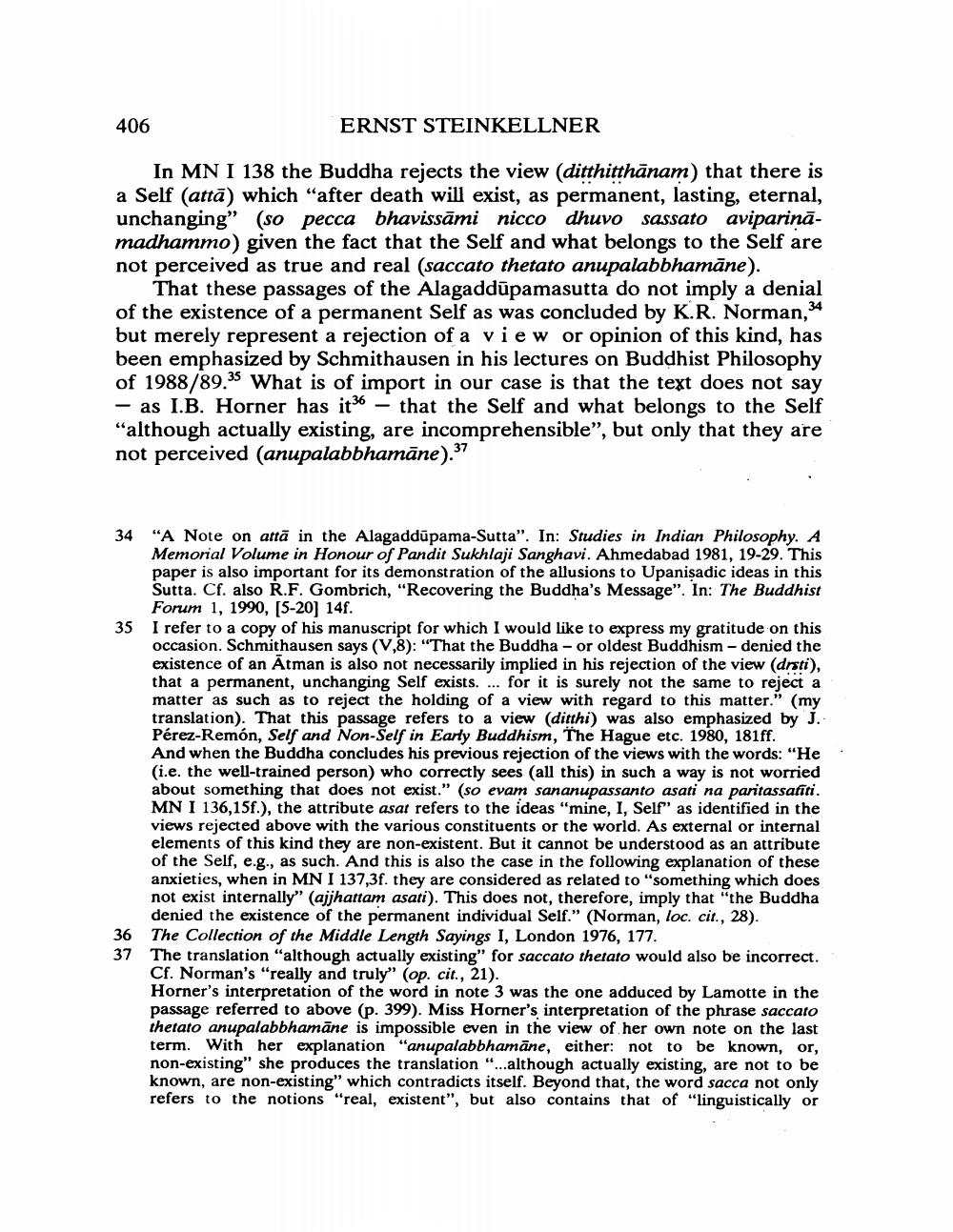________________
ERNST STEINKELLNER
In MN I 138 the Buddha rejects the view (ditthitthanam) that there is a Self (atta) which "after death will exist, as permanent, lasting, eternal, unchanging" (so pecca bhavissāmi nicco dhuvo sassato avipariņāmadhammo) given the fact that the Self and what belongs to the Self are not perceived as true and real (saccato thetato anupalabbhamāne).
406
That these passages of the Alagaddūpamasutta do not imply a denial of the existence of a permanent Self as was concluded by K.R. Norman,34 but merely represent a rejection of a view or opinion of this kind, has been emphasized by Schmithausen in his lectures on Buddhist Philosophy of 1988/89. What is of import in our case is that the text does not say
as I.B. Horner has it that the Self and what belongs to the Self "although actually existing, are incomprehensible", but only that they are not perceived (anupalabbhamāne)."7
34 "A Note on atta in the Alagaddupama-Sutta". In: Studies in Indian Philosophy. A Memorial Volume in Honour of Pandit Sukhlaji Sanghavi. Ahmedabad 1981, 19-29. This paper is also important for its demonstration of the allusions to Upanisadic ideas in this Sutta. Cf. also R.F. Gombrich, "Recovering the Buddha's Message". In: The Buddhist Forum 1, 1990, [5-20] 14f.
35 I refer to a copy of his manuscript for which I would like to express my gratitude on this occasion. Schmithausen says (V,8): "That the Buddha - or oldest Buddhism - denied the existence of an Atman is also not necessarily implied in his rejection of the view (drsti), that a permanent, unchanging Self exists. ... for it is surely not the same to reject a matter as such as to reject the holding of a view with regard to this matter." (my translation). That this passage refers to a view (ditthi) was also emphasized by J. Pérez-Remón, Self and Non-Self in Early Buddhism, The Hague etc. 1980, 181ff. And when the Buddha concludes his previous rejection of the views with the words: "He (i.e. the well-trained person) who correctly sees (all this) in such a way is not worried about something that does not exist." (so evam sananupassanto asati na paritassafīti. MN I 136,15f.), the attribute asat refers to the ideas "mine, I, Self" as identified in the views rejected above with the various constituents or the world. As external or internal elements of this kind they are non-existent. But it cannot be understood as an attribute of the Self, e.g., as such. And this is also the case in the following explanation of these anxieties, when in MN I 137,3f. they are considered as related to "something which does not exist internally" (ajjhattam asati). This does not, therefore, imply that "the Buddha denied the existence of the permanent individual Self." (Norman, loc. cit., 28). 36 The Collection of the Middle Length Sayings I, London 1976, 177.
37 The translation "although actually existing" for saccato thetato would also be incorrect. Cf. Norman's "really and truly" (op. cit., 21).
Horner's interpretation of the word in note 3 was the one adduced by Lamotte in the passage referred to above (p. 399). Miss Horner's interpretation of the phrase saccato thetato anupalabbhamane is impossible even in the view of her own note on the last term. With her explanation "anupalabbhamane, either: not to be known, or, non-existing" she produces the translation "...although actually existing, are not to be known, are non-existing" which contradicts itself. Beyond that, the word sacca not only refers to the notions "real, existent", but also contains that of "linguistically or




